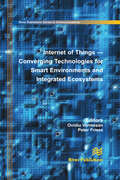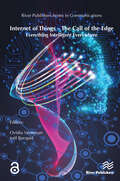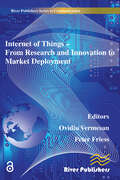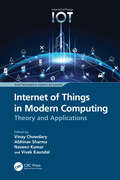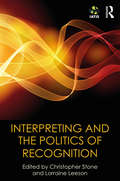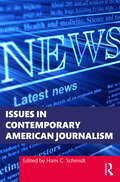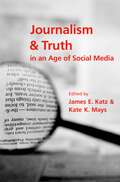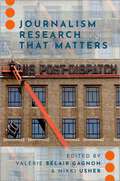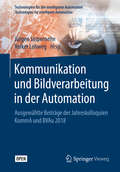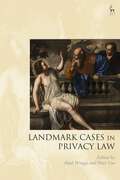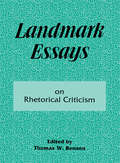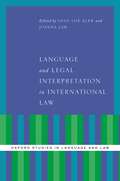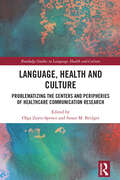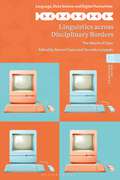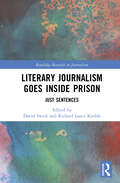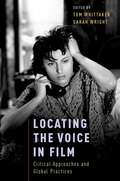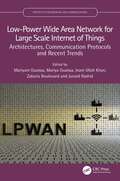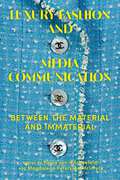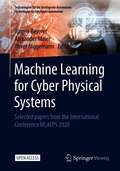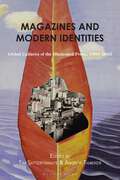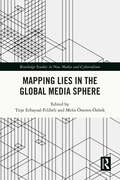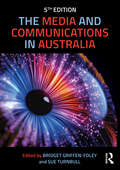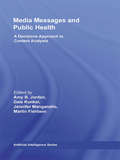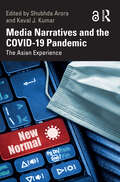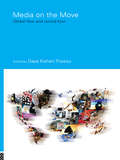- Table View
- List View
Internet of Things: Converging Technologies for Smart Environments and Integrated Ecosystems
The book aims to provide a broad overview of various topics of the Internet of Things (IoT) from the research and development priorities to enabling technologies, architecture, security, privacy, interoperability and industrial applications. It is intended to be a standalone book in a series that covers the Internet of Things activities of the IERC ? Internet of Things European Research Cluster from technology to international cooperation and the global state of play. The book builds on the ideas put forward by the European research Cluster on the Internet of Things Strategic Research Agenda and presents global views and state of the art results on the challenges facing the research, development and deployment of IoT at the global level.Today we see the integration of Industrial, Business and Consumer Internet which is bringing together the Internet of People, Internet of Things, Internet of Energy, Internet of Vehicles, Internet of Media, Services and Enterprises in forming the backbone of the digital economy, the digital society and the foundation for the future knowledge and innovation based economy in supporting solutions for the emerging challenges of public health, aging population, environmental protection and climate change, the conservation of energy and scarce materials, enhancements to safety and security and the continuation and growth of economic prosperity.Penetration of smartphones and advances in machine to machine and wireless communication technology will be the main drivers for IoT development. The IoT contribution is in the increased value of information created by the number of interconnections among things and the transformation of the processed information into knowledge shared into the Internet of Everything.
Internet of Things – The Call of the Edge: Everything Intelligent Everywhere
This book provides an overview of the Internet of Things (IoT) – covering new ideas, concepts, research and innovation to enable the development of IoT technologies in a global context. The work is intended as a standalone book in a series covering the activities of the Internet of Things European Research Cluster (IERC) – including research, technological innovation, validation, and deployment.The book chapters build on the developments and innovative ideas put forward by the IERC, the IoT European Large-Scale Pilots Programme and the IoT European Security and Privacy Projects – presenting new concepts, ideas and future IoT trends and ways of integrating open data frameworks and IoT marketplaces into larger deployment ecosystems.The IoT and Industrial Internet of Things technologies are moving towards hyperautomated solutions – combining hyperconnectivity, artificial intelligence (AI), distributed ledger technologies and virtual/augmented extended reality, with edge computing and deep edge processing becoming an assertive factor across industries for implementing intelligent distributed computing resources and data to keep the efficient data exchange and processing local to reduce latency, exploit the sensing/actuating capabilities and enable greater autonomy.Expanding the adoption of consumer, business, industrial and tactile IoT requires further development of hyperautomated IoT concepts for collaborative solutions involving machines and humans to expand augmented creativity at the application level using AI to optimise the industrial processes and progress towards a symbiotic economy based on distributed federated cloud/edge infrastructure allowing resource sharing in the form of computing, memory and analytics capabilities.The advances of autonomous IoT applications delivering services in real-time encompasses development in servitisation, robotisation, automation and hyperconnectivity, which are essential for the rapid evolution of industrial enterprises in the new digital era. The rise of digital twins integrated into IoT platforms as fully interactive elements embedded into the simulation and optimisation environment, as well as the embedment of AI techniques and methods, enhances the accuracy and performance of models in the various IoT and Industrial Internet of Things applications.The convergence of technologies to provide scalable, interoperable IoT-enabled applications pushed the requirements for high bandwidth, low latency and robust and dependable connectivity to support the industry’s demand for deeper integration and improved analytics to deliver sustainable competitive advantage products and services, enabling digital transformation with a focus on new business models.Safety and security are interlinked for the next wave of IoT technologies and applications and combined, prove a greater value for rapid adoption.The new IoT technologies are essential for facilitating sustainable development, reducing energy consumption and, by supporting the optimisation of products and processes, mitigating unnecessary carbon emissions – thereby reducing the environmental impact through real-time data collection, analysis, exchange, and processing.
Internet of Things Applications - From Research and Innovation to Market Deployment
The book aims to provide a broad overview of various topics of Internet of Things from the research, innovation and development priorities to enabling technologies, nanoelectronics, cyber physical systems, architecture, interoperability and industrial applications. It is intended to be a standalone book in a series that covers the Internet of Things activities of the IERC – Internet of Things European Research Cluster from technology to international cooperation and the global "state of play".The book builds on the ideas put forward by the European research Cluster on the Internet of Things Strategic Research Agenda and presents global views and state of the art results on the challenges facing the research, development and deployment of IoT at the global level. Internet of Things is creating a revolutionary new paradigm, with opportunities in every industry from Health Care, Pharmaceuticals, Food and Beverage, Agriculture, Computer, Electronics Telecommunications, Automotive, Aeronautics, Transportation Energy and Retail to apply the massive potential of the IoT to achieving real-world solutions. The beneficiaries will include as well semiconductor companies, device and product companies, infrastructure software companies, application software companies, consulting companies, telecommunication and cloud service providers. IoT will create new revenues annually for these stakeholders, and potentially create substantial market share shakeups due to increased technology competition. The IoT will fuel technology innovation by creating the means for machines to communicate many different types of information with one another while contributing in the increased value of information created by the number of interconnections among things and the transformation of the processed information into knowledge shared into the Internet of Everything. The success of IoT depends strongly on enabling technology development, market acceptance and standardization, which provides interoperability, compatibility, reliability, and effective operations on a global scale. The connected devices are part of ecosystems connecting people, processes, data, and things which are communicating in the cloud using the increased storage and computing power and pushing for standardization of communication and metadata. In this context security, privacy, safety, trust have to be address by the product manufacturers through the life cycle of their products from design to the support processes. The IoT developments address the whole IoT spectrum - from devices at the edge to cloud and datacentres on the backend and everything in between, through ecosystems are created by industry, research and application stakeholders that enable real-world use cases to accelerate the Internet of Things and establish open interoperability standards and common architectures for IoT solutions. Enabling technologies such as nanoelectronics, sensors/actuators, cyber-physical systems, intelligent device management, smart gateways, telematics, smart network infrastructure, cloud computing and software technologies will create new products, new services, new interfaces by creating smart environments and smart spaces with applications ranging from Smart Cities, smart transport, buildings, energy, grid, to smart health and life. Technical topics discussed in the book include: • Introduction• Internet of Things Strategic Research and Innovation Agenda• Internet of Things in the industrial context: Time for deployment.• Integration of heterogeneous smart objects, applications and services• Evolution from device to semantic and business interoperability• Software define and virtualization of network resources• Innovation through interoperability and standardisation when everything is connected anytime at anyplace• Dynamic context-aware scalable and trust-based IoT Security, Privacy framework• Federated Cloud service management and the Internet of Things• Internet of Things Applications
Internet of Things in Modern Computing: Theory and Applications (Smart Technologies for Engineers and Scientists)
The text focuses on the theory, design, and implementation of the Internet of Things (IoT), in a modern communication system. It will be useful to senior undergraduate, graduate students, and researchers in diverse fields domains including electrical engineering, electronics and communications engineering, computer engineering, and information technology. Features: Presents all the necessary information on the Internet of Things in modern computing Examines antenna integration challenges and constraints in the Internet of Things devices Discusses advanced Internet of Things networks and advanced controllers required for modern architecture Explores security and privacy challenges for the Internet of Things-based health care system Covers implementation of Internet of Things security protocols such as MQTT, Advanced Message Queuing Protocol, XMPP, and DSS The text addresses the issues and challenges in implementing communication and security protocols for IoT in modern computing. It further highlights the applications of IoT in diverse areas including remote health monitoring, remote monitoring of vehicle data and environmental characteristics, industry 4.0, 5G communications, and Next-gen IoT networks. The text presents case studies on IoT in modern digital computing. It will serve as an ideal reference text for senior undergraduate, graduate students, and academic researchers in diverse fields domains including electrical engineering, electronics and communications engineering, computer engineering, and information technology.
Interpreting and the Politics of Recognition: The IATIS Yearbook (The IATIS Yearbook)
Interpreting and the Politics of Recognition investigates the historical, ethical and professional dimensions of this, arguably, most widespread form of intercultural communication. Covering key topics from colonialism to representation, ethics and power, it looks at the different linguistic modalities (signed and spoken) used within communities to investigate equality of citizens. The contributors include leading authorities in their fields and use a wide spread of examples from a variety of disparate cultures – including deaf and ethnic minority groups. With eight chapters presented in three thematic sections and a foreword by Michael Cronin setting the book in its wider context, this volume will be of interest to practising interpreters, researchers and advanced students in the areas of Interpreting Studies, Translation Studies, and Linguistics and Communication Studies. Additional resources for Translation and Interpreting Studies are available on the Routledge Translation Studies Portal: http://cw.routledge.com/textbooks/translationstudies.
Issues in Contemporary American Journalism
Bringing together the diverse perspectives of over 20 leading journalism scholars, this collection provides an original insight into the history of American journalism and issues that exist and have existed within the industry for decades. The culture of journalism is in constant flux, with both individual journalists and the news industry as a whole regularly finding themselves at the center of controversy. While heightened in recent years, such controversy is not new and could in fact be considered a hallmark of the profession. With this in mind, this book presents original perspectives into issues and debates regarding the role of journalism in America, journalistic objectivity and ethics, diversity and representation, war and conflict reporting, local news, fake news, and hostility towards journalists. Each of the seven sections begins with a topical overview and ends with a short essay written by a leader in the field. Issues in Contemporary American Journalism is recommended reading for anyone studying the history and evolution of journalism in the US at an advanced level.
Journalism and Truth in an Age of Social Media
Truth qualities of journalism are under intense scrutiny in today's world. Journalistic scandals have eroded public confidence in mainstream media while pioneering news media compete to satisfy the public's appetite for news. Still worse is the specter of "fake news" that looms over media and political systems that underpin everything from social stability to global governance. This volume aims to illuminate the contentious media landscape to help journalism students, scholars, and professionals understand contemporary conditions and arm them to deal with a spectrum of new developments ranging from technology and politics to best practices. Fake news is among the greatest of these concerns, and can encompass everything from sarcastic or ironic humor to bot-generated, made-up stories. It can also include the pernicious transmission of selected, biased facts, the use of incomplete or misleadingly selective framing of stories, and photographs that editorially convey certain characteristics. This edited volume contextualizes the current "fake news problem." Yet it also offers a larger perspective on what seems to be uniquely modern, computer-driven problems. We must remember that we have lived with the problem of people having to identify, characterize, and communicate the truth about the world around them for millennia. Rather than identify a single culprit for disseminating misinformation, this volume examines how news is perceived and identified, how news is presented to the public, and how the public responds to news. It considers social media's effect on the craft of journalism, as well as the growing role of algorithms, big data, and automatic content-production regimes. As an edited collection, this volume gathers leading scholars in the fields of journalism and communication studies, philosophy, and the social sciences to address critical questions of how we should understand journalism's changing landscape as it relates to fundamental questions about the role of truth and information in society.
Journalism Research That Matters (Journalism and Political Communication Unbound)
It is now well-established that the long-time economic model on which the news industry has relied is no longer sustainable. Facebook, Google, and declining levels of popular trust in the media have been major contributors to this situation. Simultaneously, the closure of local media outlets across the country has left many areas without access to regional news, compounded the distance between media and publics, and further eroded civic engagement. Despite the looming crisis in journalism, a research-practice gap plagues the news industry. This book argues that an underappreciated factor in the news crisis is a potentially symbiotic relationship between journalism studies and the industry that it researches. As this book contends, scholars must think about their work in a public context, and journalists, too, need to listen to media scholars and take the research that they do seriously. Including contributions from journalists and academics, Journalism Research That Matters offers journalists a guide on what they need to know and journalism scholars a call to action for what kind of research they can do to best help the news industry reckon with disruption. The book looks at new research developments surrounding audience behavior, social networks, and journalism business models; the challenges that scholars face in making their research available to the public and to journalists; the financial survival of quality news and information; and blind spots in the way that researchers and journalists do their work, especially around race, diversity, and inequality. A final section includes contributions from journalists about how researchers can better engage on the ground with newsrooms and media professionals.
Kommunikation und Bildverarbeitung in der Automation: Ausgewählte Beiträge der Jahreskolloquien KommA und BVAu 2018 (Technologien für die intelligente Automation #12)
In diesem Open-Access-Tagungsband sind die besten Beiträge des 9. Jahreskolloquiums "Kommunikation in der Automation" (KommA 2018) und des 6. Jahreskolloquiums "Bildverarbeitung in der Automation" (BVAu 2018) enthalten. Die Kolloquien fanden am 20. und 21. November 2018 in der SmartFactoryOWL, einer gemeinsamen Einrichtung des Fraunhofer IOSB-INA und der Technischen Hochschule Ostwestfalen-Lippe statt.Die vorgestellten neuesten Forschungsergebnisse auf den Gebieten der industriellen Kommunikationstechnik und Bildverarbeitung erweitern den aktuellen Stand der Forschung und Technik. Die in den Beiträgen enthaltenen anschaulichen Beispiele aus dem Bereich der Automation setzen die Ergebnisse in den direkten Anwendungsbezug.
Landmark Cases in Privacy Law (Landmark Cases)
This new addition to Hart's acclaimed Landmark Cases series is a diverse and engaging edited collection bringing together eminent commentators from the United Kingdom, the United States, Australia, Canada, and New Zealand, to analyse cases of enduring significance to privacy law.The book tackles the conceptual nature of privacy in its various guises, from data protection, to misuse of private information, and intrusion into seclusion. It explores the practical issues arising from questions about the threshold of actionability, the function of remedies, and the nature of damages.The cases selected are predominantly English but include cases from the United States (because of the formative influence of United States' privacy jurisprudence on the development of privacy law), Australia, Canada, the Court of Justice of the European Union, and the European Court of Human Rights. Each chapter considers the reception and application (and, in some instances, rejection) outside of the jurisdiction where the case was decided.
Landmark Essays on Rhetorical Criticism: Volume 5
This book is an anthology of landmark essays in rhetorical criticism. In historical usage, a landmark marks a path or a boundary; as a metaphor in social and intellectual history, landmark signifies some act or event that marks a significant achievement or turning point in the progress or decline of human effort. In the history of an academic discipline, the historically established senses of landmark are mixed together, jostling to set out and protect the turfmarkers of academic specialization; aligning footnotes to signify the beacons that have guided thought and, against these "conservative" tendencies, attempting to contribute fresh insights that tempt others along new trails. The editor has chosen essays for this collection that give some sense of the history of rhetorical criticism in this century, especially as it has been practiced in the discipline of speech communication. He also emphasizes materials that may illustrate where the discipline conceives itself to be going -- how it has marked its boundaries; how it has established beacons to invite safety or warn us from the rocks; and how it has sought to preserve a tradition by subjecting it to constant revision and struggle. In the hope of providing some coherence, the scope of this collection is limited to rhetorical criticism as it has been practiced and understood within the discipline of speech communication in North America in this century.
Language and Legal Interpretation in International Law (Oxford Studies in Language and Law)
International law is usually communicated in more than one language and reflects common norms that lawyers and adjudicators across national legal cultures agree on and develop together. As a result, the negotiation of the wording and meaning of international legislative texts is an integral part of legal interpretation in international law. This book sheds light on that essential interpretation process. Language and Legal Interpretation in International Law treats the subject from the perspective of recent legal and linguistic theories of meaning. Anne Lise Kjær and Joanna Lam bring together internationally renowned experts to provide strong theoretical and practical foundations for the study of legal interpretation in such fields as human rights law, international trade, investment and commercial law, EU law, and international criminal law. The volume explains how the positivist tradition--in which interpretation is understood as an automatic process by which judges simply apply the text of legislative instruments to specific fact situations--cannot be upheld in an era of pragmatic and cognitive meaning theories. Those theories instead focus on the context of interpretation and on the interpreter as a co-producer of meaning. Through a collection of thoroughly researched and timely essays, this book explores the linguistically and culturally diversified world of meaning-making in international law.
Language, Health and Culture: Problematizing the Centers and Peripheries of Healthcare Communication Research (Routledge Studies in Language, Health and Culture)
Language, Health and Culture brings together contributions by linguistic scholars working in the area of health communication in Asia—in particular, in Hong Kong, Mainland China, Singapore, Japan and Taiwan. Olga Zayts-Spence and Susan M. Bridges, along with the contributors, draw on a diverse range of authentic data from different (primary, secondary, digital) healthcare contexts across Asia. The contributions probe empirical analyses and meta-reflections on the empirical, epistemological and theoretical foundations of doing research on language and health communication in Asia. While many of the medical and technological advances originate from the ‘non-English-dominant’/‘peripheral’ contexts, when it comes to health communication, there is a strong tendency to downplay and marginalize the scope and the impact of the ripe research tradition in these contexts. The contributions to the edited volume problematize the hegemony of dominant (Anglocentric) traditions in health communication research by highlighting culture- and context-specific ways of interpreting different health realities through linguistic lenses.
Linguistics across Disciplinary Borders: The March of Data (Language, Data Science and Digital Humanities)
This volume highlights the ways in which recent developments in corpus linguistics and natural language processing can engage with topics across language studies, humanities and social science disciplines.New approaches have emerged in recent years that blur disciplinary boundaries, facilitated by factors such as the application of computational methods, access to large data sets, and the sharing of code, as well as continual advances in technologies related to data storage, retrieval, and processing. The “march of data” denotes an area at the border region of linguistics, humanities, and social science disciplines, but also the inevitable development of the underlying technologies that drive analysis in these subject areas.Organized into 3 sections, the chapters are connected by the underlying thread of linguistic corpora: how they can be created, how they can shed light on varieties or registers, and how their metadata can be utilized to better understand the internal structure of similar resources. While some chapters in the volume make use of well-established existing corpora, others analyze data from platforms such as YouTube, Twitter or Reddit. The volume provides insight into the diversity of methods, approaches, and corpora that inform our understanding of the “border regions” between the realms of data science, language/linguistics, and social or cultural studies.
Literary Journalism Goes Inside Prison: Just Sentences (Routledge Research in Journalism)
Literary Journalism Goes Inside Prison: Just Sentences opens up a new exploration of literary journalism – immersive, long-form journalism so beautifully written that it can stand as literature – in the first anthology to examine literary journalism and prison. In this book, a wide range of compelling subjects are considered. These include Nelson Mandela and other prisoners of apartheid; the made-in-prison podcast Ear Hustle; women’s experiences of life behind bars; Behrouz Boochani’s 2018 bestseller No Friend but the Mountains; George Orwell’s artful writing on incarceration; Pete Earley’s immersion into the largest prison in the United States, The Hot House; Arthur Koestler and the Spanish Civil War; Ted Conover’s year as a prison guard in Newjack: Guarding Sing Sing and (most originally) Bruce Springsteen’s execution narrative Nebraska. This volume will benefit anyone who writes, studies or teaches any form of narrative nonfiction. Eleven international scholars articulate what makes the work they are analysing so exceptional. At the same time, they offer insights on a diverse range of vital topics. These include journalism ethics, journalism and trauma, media history, cultural studies, criminology and social justice.
Locating the Voice in Film: Critical Approaches and Global Practices
Where is the place of the voice in film? Where others have focused on Hollywood film, this volume aims to extend the field to other cinemas from around the world, encompassing Latin America, Asia and Africa amongst others. Traditional theoretical accounts, based on classical narrative cinema, examine the importance of the voice in terms of a desired perfect match between visuals and sonic effects. But, as the chapters of this volume illustrate, what is normative in one film industry may not apply in another. The widespread practices of dubbing, postsynch sound and "playback singing" in some countries, for instance, provide an alternative means of understanding the location of the voice in the soundtrack. Through seventeen original chapters, this volume situates the voice in film across a range of diverse national, transnational and cultural contexts, presenting readings which challenge traditional readings of the voice in film in exciting new ways. By taking a comparative view, this volume posits that the voice may be best understood as a mobile object, one whose trajectory follows a broader network of global flows. The various chapters explore the cultural transformations the voice undergoes as it moves from one industry to another. In doing so, the volume addresses sound practices which have been long been neglected, such as dubbing and non-synch sound, as well the ways in which sound technologies have shaped nationally specific styles of vocal performance. In addressing the place of the voice in film, the book intends to nuance existing theoretical writing on the voice while applying these critical insights in a global context.
Low-Power Wide Area Network for Large Scale Internet of Things: Architectures, Communication Protocols and Recent Trends (Prospects in Networking and Communications – P-NetCom)
This book presents a comprehensive exploration of LPWANs, delving into their fundamental concepts, underlying technologies, and the multifaceted challenges they tackle. This book recognizes that LPWANs don't operate in isolation; they are intimately intertwined with Artificial Intelligence and Machine Learning (AI/ML) technologies, which play a pivotal role in optimizing LPWAN performance and capabilities. The book is a collection of original contributions regarding air interface, transmission technologies and novel network architectures, such as network slicing, cloud/fog/edge computing, ad hoc networks and software-defined network. Also, this book provides a guide for researchers of IoT applications to choose suitable LPWAN technologies and describe the design aspects, network architectures, security issues and challenges.Features: Explains machine learning algorithms onto low-power wide area network sensors for compressed communications. Illustrates wireless-based Internet of Things networks using low-power wide area networks technology for quality air. Presents cognitive Internet of Things networks using wireless communication, and low-power wide area network technologies for Ad Hoc networks. Discusses a comprehensive study of low-power wide area networks for flying Ad Hoc networks. Showcases the study of energy efficient techniques aided by low-power wide area network technologies for the Internet of Things networks. The text is aimed at senior undergraduate, graduate students, and academic researchers in the fields of electrical engineering, electronics and communication engineering, computer engineering, and information technology.
Luxury Fashion and Media Communication: Between the Material and Immaterial
Using image and film advertisements, interviews, social media and public and private archives, Luxury Fashion and Media Communication offers an interdisciplinary approach to analyzing the value of the luxury object. Regular reports on consumption in media and frequent advertising on social media have allowed people all over the world to share in the issues and development of luxury; but how is it communicated, and how has it affected the consumer?An international range of scholars explore the material and immaterial value and meaning of luxury, how it is materialized and how it is communicated between the luxury industry and the consumer. Investigating French, Italian and Spanish luxury brands and their communication strategies on the global market, and including two chapters focusing specifically on the Chinese and American markets, they examine the ambiguity of the luxury commodity. This volume shows particularly the conflicting narratives between the idea of exclusivity and human skills and their mass marketing.In exploring theoretical perspectives alongside the practicalities of how luxury is communicated, Luxury Fashion and Media Communication reveals the value of the luxury object and the consumer's behaviour in relation to that value. It offers an innovative and important intervention in the inter-related fields of luxury fashion, media and communication, and key reading for scholars, students and practitioners wishing to explore the material and immaterial value of luxury.
Machine Learning for Cyber Physical Systems: Selected papers from the International Conference ML4CPS 2020 (Technologien für die intelligente Automation #13)
This open access proceedings presents new approaches to Machine Learning for Cyber Physical Systems, experiences and visions. It contains selected papers from the fifth international Conference ML4CPS – Machine Learning for Cyber Physical Systems, which was held in Berlin, March 12-13, 2020. Cyber Physical Systems are characterized by their ability to adapt and to learn: They analyze their environment and, based on observations, they learn patterns, correlations and predictive models. Typical applications are condition monitoring, predictive maintenance, image processing and diagnosis. Machine Learning is the key technology for these developments.
Magazines and Modern Identities: Global Cultures of the Illustrated Press, 1880–1945
In the late nineteenth and early twentieth century, ideals of technological progress and mass consumerism shaped the print cultures of countries across the globe. Magazines in Europe, the USA, Latin America, and Asia inflected a shared internationalism and technological optimism. But there were equally powerful countervailing influences, of patriotic or insurgent nationalism, and of traditionalism, that promoted cultural differentiation. In their editorials, images, and advertisements magazines embodied the tensions between these domestic imperatives and the forces of global modernity.Magazines and Modern Identities explores how these tensions played out in the magazine cultures of ten different countries, describing how publications drew on, resisted, and informed the ideals and visual forms of global modernism. Chapters take in the magazines of Australia, Europe and North America, as well as China, The Soviet Turkic states, and Mexico. With contributions from leading international scholars, the book considers the pioneering developments in European and North American periodicals in the modernist period, whilst expanding the field of enquiry to take in the vibrant magazine cultures of east Asia and Latin America. The construction of these magazines' modern ideals was a complex, dialectical process: in dialogue with international modernism, but equally responsive to their local cultures, and the beliefs and expectations of their readers. Magazines and Modern Identities captures the diversity of these ideals, in periodicals that both embraced and criticised the globalised culture of the technological era.
Mapping Lies in the Global Media Sphere (Routledge Studies in New Media and Cyberculture)
This volume addresses the concept of “(in)nocent lies” in the media – beyond the concept of misleading information online, this extends to a deliberate effort to spread misinformation, disinformation and conspiracy theories – and proposes a critical approach to tackle the issue in related interdisciplinary fields. The book takes a multidisciplinary and international approach, addressing the digital divide and global inequality, as well as algorithmic bias, how misinformation harms vulnerable groups, social lynching and the effect of misinformation on certain social, political and cultural agendas, among other topics. Arranged thematically, the chapters paint a nuanced and original picture of this issue. This book will be of interest to students and academics in the areas of digital media, media and politics, journalism, development studies, gender and race.
The Media and Communications in Australia
At a time when the traditional media have been reshaped by digital technologies and audiences have fragmented, people are using mediated forms of communication to manage all aspects of their daily lives as well as for news and entertainment. The Media and Communications in Australia offers a systematic introduction to this dynamic field. Fully updated and expanded, this fifth edition outlines the key media industries – from print, sound and television to film, gaming and public relations – and explains how communications technologies have changed the ways in which they now operate. It offers an overview of the key approaches to the field, including a consideration of Indigenous communication, and features a ‘hot topics’ section with contributions on issues including diversity, misinformation, algorithms, COVID-19, web series and national security. With chapters from Australia’s leading researchers and teachers in the field, The Media and Communications in Australia remains the most comprehensive and reliable introduction to media and communications from an Australian perspective. It is an ideal student text and a key resource for teachers, lecturers, media practitioners and anyone interested in understanding these influential industries.
Media Messages and Public Health: A Decisions Approach to Content Analysis
Media Messages and Public Health addresses the full range of methodological and conceptual issues involved in content analysis research, specifically focused on public health-related messages and behaviors. Uniquely tailored to the challenges faced by content researchers interested in the study of public health topics, coverage includes: Conceptual and methodological foundations involved in the practice of content analysis research used to examine public health issues. Measurement challenges posed by the broad range of media. Use of content analysis across multiple media types. The potential for individual differences in audience interpretation of message content. Case studies that examine public health issues in the media to illustration the decisions that are made when developing content analysis studies. The volume concludes with a set of guidelines for optimal content analysis research, and suggests ways in which the field can accommodate new technologies and new ways of using media. Developed for researchers in communication, media, and public health, this unique resource demonstrates how the variety of decisions researchers make along the way allows the exploration of traditions, assumptions and implications for each varying alternative and ultimately advances the science of content analysis research.
Media Narratives and the COVID-19 Pandemic: The Asian Experience
This volume investigates mediated lives and media narratives during the Covid-19 pandemic, with Asia as a focus point. It shows how the pandemic has created an unprecedented situation in this globalized world marked by many disruptions in the social, economic, political, and cultural lives of individuals and communities— creating a ‘new normal’. It explores the different media vocabularies of fear, panic, social distancing, and contagion from across Asian nations. It focuses on the role media played as most nations faced lockdowns and unique challenges during the crisis. From healthcare workers to sex workers, from racism to nationalism, from the plight of migrant workers in news reporting to state propaganda, this book brings critical questions confronting media professionals into focus.The volume is of critical interest to scholars and researchers of media and communication studies, politics, especially political communication, social and public policy, and Asian studies.
Media on the Move: Global Flow and Contra-Flow (Communication and Society)
Media on the Move provides a critical analysis of the dynamics of the international flow of images and ideas. This comes at a time when the political, economic and technological contexts within which media organisations operate are becoming increasingly global. The surge in transnational traffic in media products has primarily benefited the major corporations such as Disney, AOL, Time Warner and News Corporation. However, as this book argues, new networks have emerged which buck this trend: Brazilian TV is watched in China, Indian films have a huge following in the Arab world and Al Jazeera has become a household name in the West. Combining a theoretical perspective on contra-flow of media with grounded case studies into one up-to-date and accessible volume, Media on the Move provides a much-needed guide to the globalization of media, going beyond the standard Anglo-American view of this evolving phenomenon.
